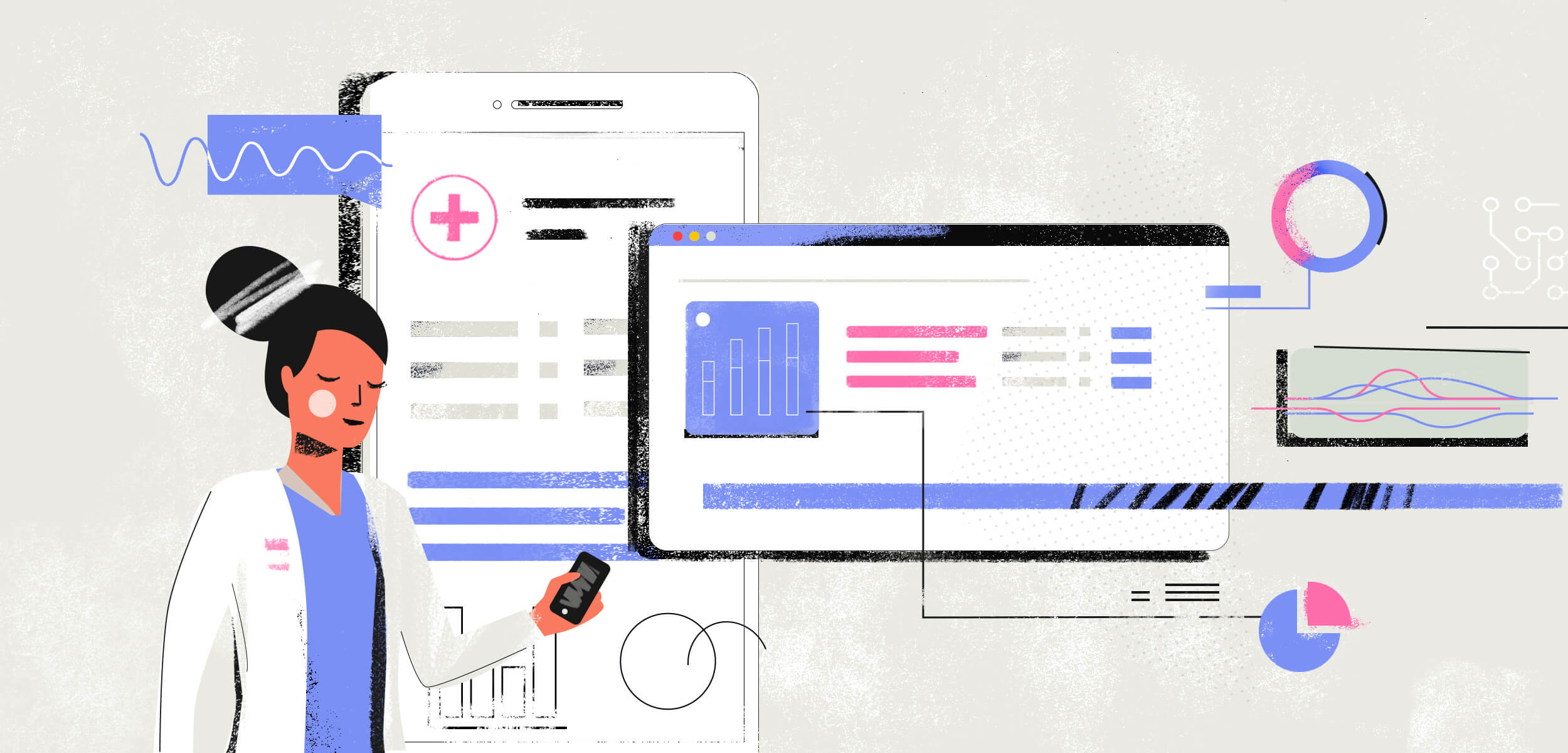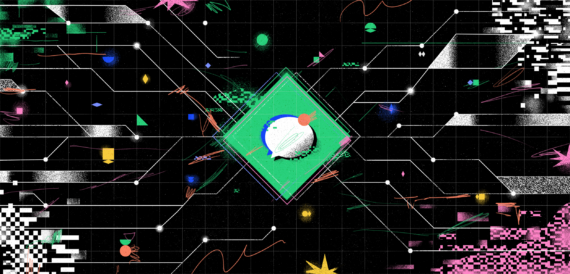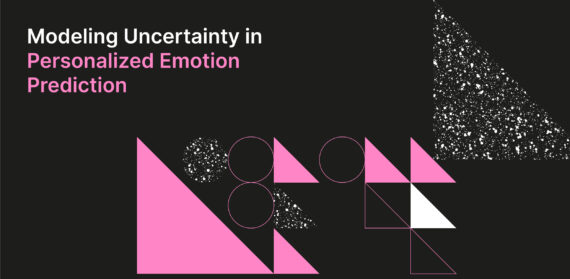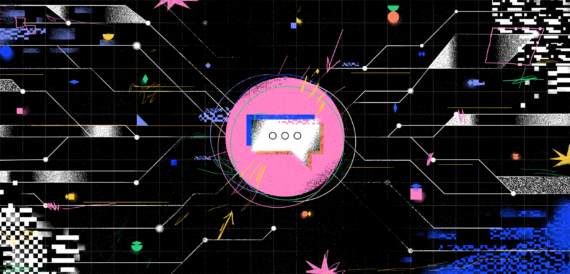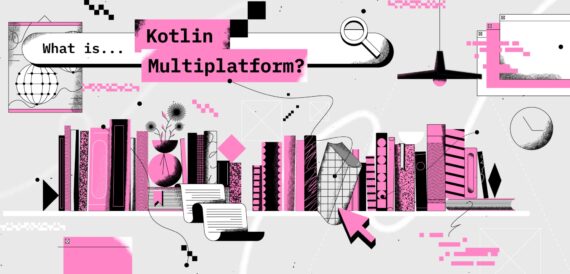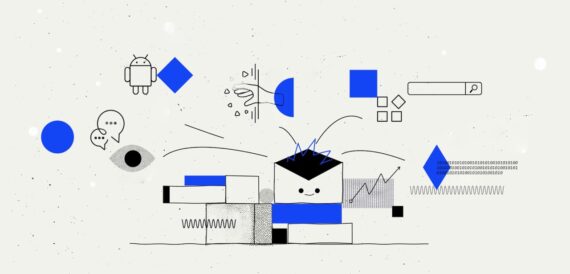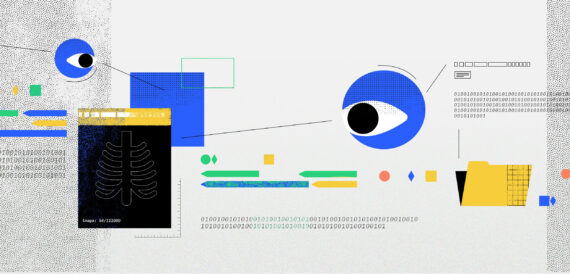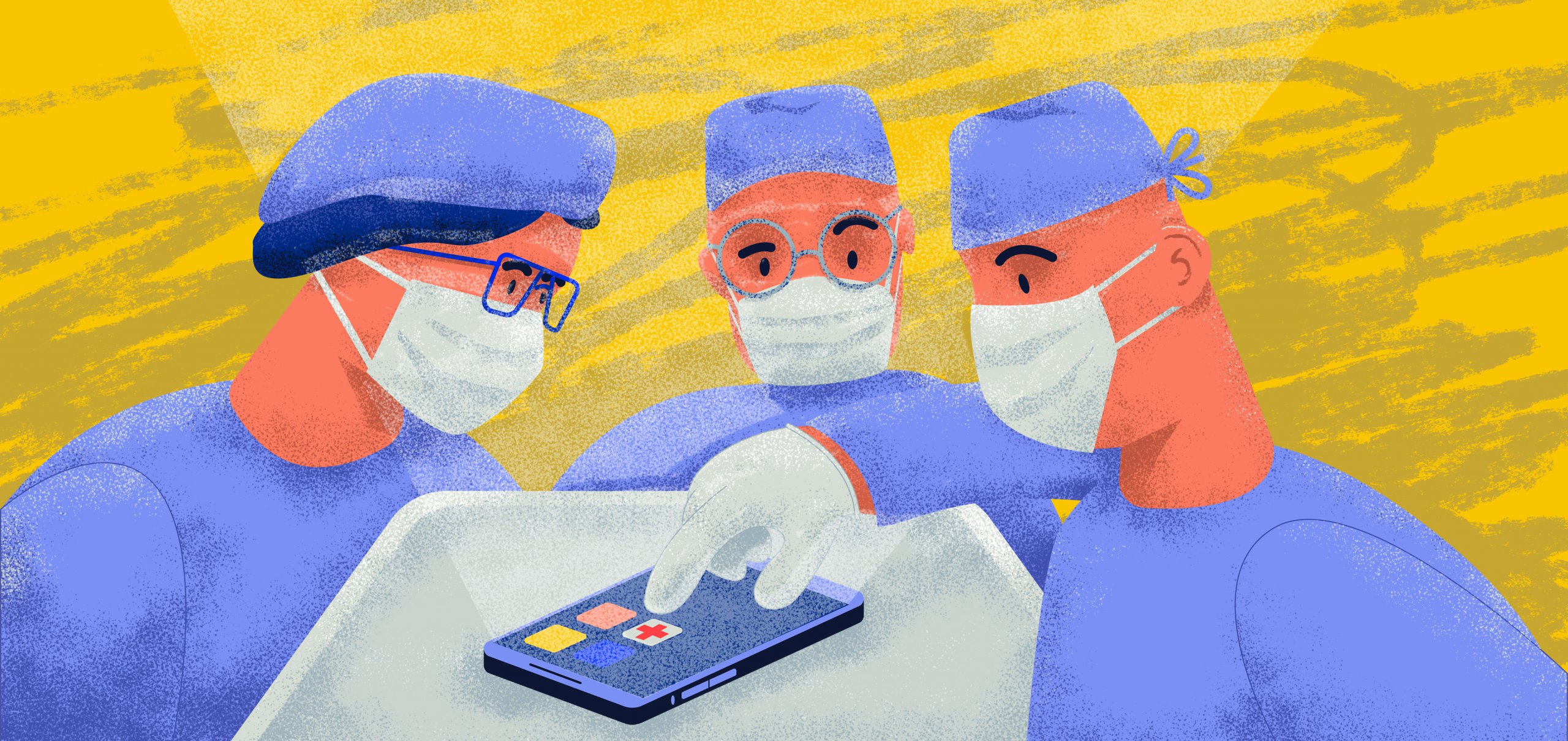
We’re now solving most of our everyday problems using smartphones and other mobile devices. In new COVID-19 realities, turning to remote services has become not only a matter of convenience, but one of necessity.
What once was perceived as a very conventional area based on human and face-to-face interactions, has now morphed into a digital experience–and a life-saving one at that.
This text looks at:
- the mHealth apps market
- a definition of mHealth
- Healthcare apps for institutions
- Healthcare apps for medical professionals
- Healthcare apps for patients
- What’s next?
- Trends shaping healthcare
The mHealth apps market
The healthcare app industry was doing well and worth a lot long before the pandemic hit. As far back as 2017, the overall global healthcare mobile app market was valued at around 10 billion U.S. dollars. It was estimated that the market will grow to over 31 billion dollars by 2025.
According to Statista, by 2021 the global mHealth market is estimated to reach $100 billion, accounting for nearly half of the predicted total digital healthcare share of $206 billion.
According to research2guidance.com,
- there are more than 95,000 medical apps for doctors and patients listed in AppStore catalogs;
- almost 45% of mHealth apps use a paid business model
- 15% are aimed at healthcare experts (CME, PRM, healthcare mgt);
- the most popular mobile health apps generate about 5 million free and 300,000 paid downloads globally per day.
Healthcare mobile apps gaining popularity does not seem surprising now, with pandemic reality forcing the rise of health-supporting technologies. But even before this catastrophic catalyzation, mHealth was becoming more entrenched.
Key factors that were driving the healthcare mobile application market growth pre-pandemic included expanded use of smartphones, more accessible internet connectivity, expanding digital healthcare services in general, and increased user awareness of the benefits of fitness, wellness, and technical knowledge.
The market is also drawing the attention of more and more investors. The 2019 data indicates that Biotechnology, Biopharma, and Healthcare are considered especially attractive by venture capitalists, with the first attracting $18,285B dollar in funding.
what is mHealth?
While ‘healthcare mobile app development’ is a process of providing digital services for the healthcare industry, the term ‘mHealth’ generally denotes the use of mobile devices and wireless technologies to promote a healthy lifestyle. The term also encompasses serious medical care, patient-doctor relations management, medical data and documents, healthcare gov apps, and fitness and wellness.
The most popular examples of mHealth technologies are different types of healthcare apps designed to help people track, guide and bolster their physical condition.
In general, most of the mobile apps dedicated to healthcare fall into three categories: healthcare apps for institutions, medical apps for professionals, and healthcare apps for patients.
Healthcare Apps For Institutions
The system of healthcare organizations is increasingly turning to mobile solutions to improve interoperability and care coordination. Billing, appointments and scheduling, inventory management in hospitals, and PE offices are more and more often now handled with mobile services, providing improvements to workflow management.
On a more advanced level, clinical assistance applications with access to EMR and EHR help in managing sensitive healthcare data while boosting both accessibility and security.
Healthcare Apps For Medical Professionals
The vast quantity of ever-evolving knowledge health professionals must have at their command makes their jobs challenging. Mobile devices have become very handy (pun intended) efficiency tools for physicians. Providing real-time insights and, for example, remote monitoring can help avoid human error and provide more reliable results needed for further patient treatment.
The most popular mHealth apps for medical professionals include
- Patient health tracking apps,
- Telehealth mobile apps (doctor-on-demand) and remote diagnostics,
- Symptom lists, medical publications, and reference databases,
- Professional networking apps (for doctors from all around the globe to get proven recommendations from leading experts),
- apps that support medical examinations
- Communication and appointment-management tools.
Healthcare Apps For Patients
Mobile and wearable healthcare devices are becoming more popular every year. By 2019, revenue from worldwide healthcare wearable device sales was expected to grow to around 4.4 billion U.S. dollars. The most common apps used by patients and individual consumers are:
- Patient healthcare education apps (patient portals) – to monitor useful information
- Reminder apps – including tracking apps and healthy habit reminders (e.g. water consumption)
- Diagnosis apps – for preventive purposes
- Healthy lifestyle apps – health tests, fitness and wellness apps, cardio apps
- Monitoring apps – for managing a chronic condition like diabetes, blood pressure, and or cancer
- Mental health apps – stress relief apps, meditation apps, apps for good sleep
- Dieting apps – trackers, exercise, weight loss apps
- Women’s health apps – for pregnancy, feeding, or menstrual cycle calendars
What’s next?
However rich in massive breakthroughs and crucial discoveries it may be, the healthcare industry is seen as a relatively slow-paced one. The mobile health market is no older than 10 years – an eternity in technology discourse, yet in medicine a typical timeline for discovering a new drug, procedure, or vaccine.
Effectively combining these two very different habitats – slow-paced healthcare and the disruptively fast digital ecosystem – could well become a daunting undertaking. Nonetheless, the real revolution is yet to arrive, even with the vast number of technological solutions available today. One thing is for certain, though, the COVID-19 global pandemic crisis will usher in change earlier than it would have come otherwise.
So what technologies and innovations can be still utilized within the healthcare industry today? And which of those could be applied in mobile app development?
Trends shaping the healthcare mobile industry
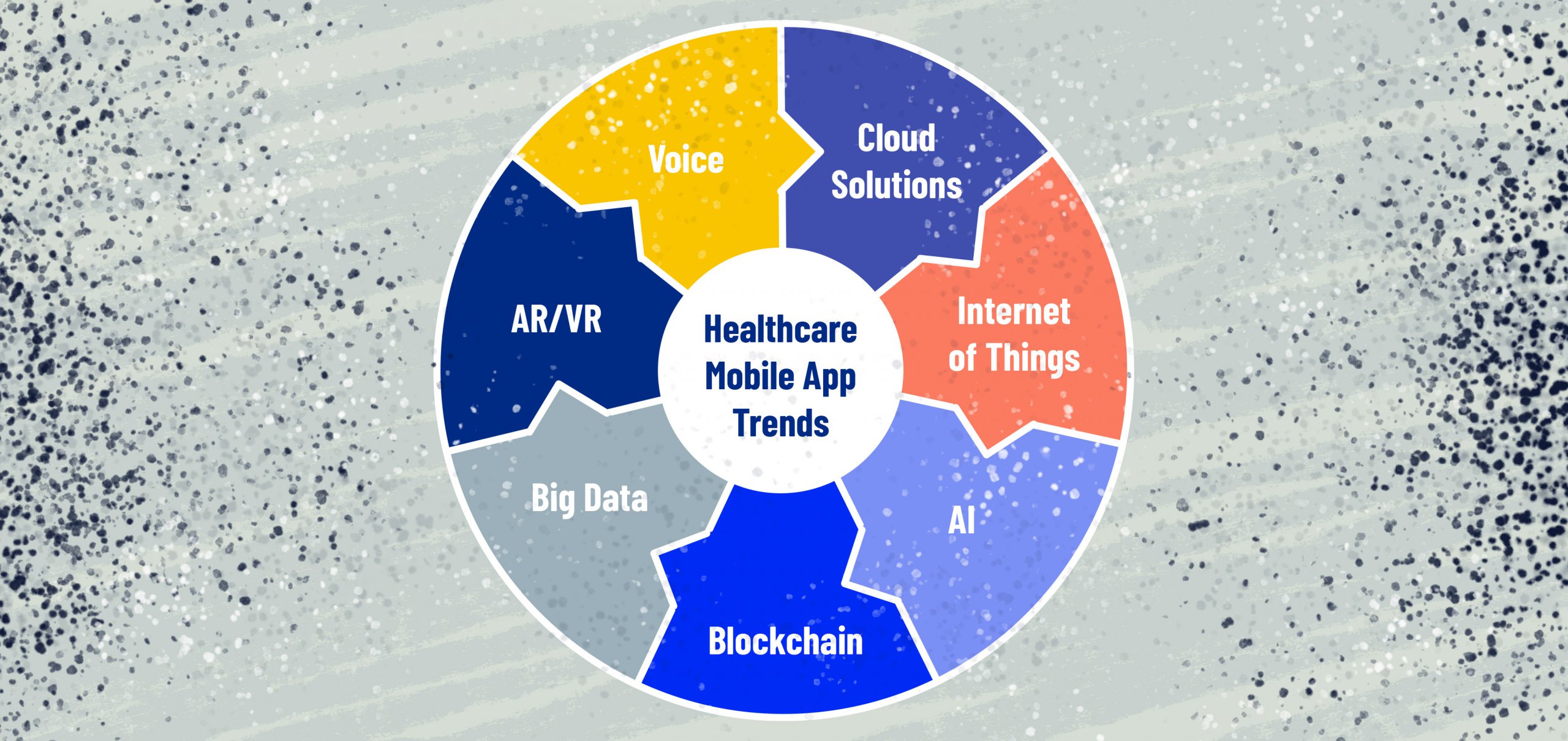
AI
That AI is finding robust application in mobile healthcare should come as no surprise. AI already is supporting healthcare digital transformation and altering the perception of modern services in healthcare. Its ability to transform the healthcare industry put AI on the list as one of the most significant developments in healthcare applications. According to PwC data, the market for AI in healthcare is predicted to grow to $6,662 millions in 2021.
AI is expected to bring more major breakthroughs, especially in the field of self-examination and other remote procedures. Solutions that reduce the costs of visits to clinics and patient-doctor contact are likely to become profitable in the pandemic and post-pandemic world.
Big Data
Healthcare is a multi-dimensional system required on several levels of health-related issues or impairments in human beings. On each of these levels an enormous amount of data has to be collected, stored, retrieved, linked, often manipulated and analyzed.
The management and use of such healthcare data more and more now depends on information technology, as the wide-scale use of EHRs (Electronic Health Records) clearly attests, however, slow they may have been taken up.
But there are a number of other areas of healthcare that stand to benefit from the industry’s incorporation of Big Data. The prospect of cutting down mistakes in medication, boosting reactive or preventive care, reducing waiting times and costs in hospitals, resource management, and predicting diagnoses might make Big Data healthcare technology the most sought-after technology of the near future.
Blockchain
Keeping these massive amounts of data secure is a major concern within the healthcare industry. That 176 million patient records were exposed in breaches between 2009 and 2017 certainly justifies that concern.
The most widely used blockchain healthcare application at the moment is keeping important medical data safe and secure. Blockchain has an amazing ability to keep an incorruptible, decentralized, and transparent log of all patient data.
This transparency and the ability to conceal the identity of any individual with complex and secure codes can protect the sensitivity of medical data. Its decentralized nature makes Blockchain a technology that will be widely used in healthcare app development.
IoT
The potential of the Internet of Things likewise holds great promise for healthcare. A study conducted by Aruba Networks in 2017 showed that 60 percent of healthcare organizations worldwide have already implemented IoT devices in their facilities, while the number will increase dramatically in the coming years.
Consider the example of a promising and prominent innovation, the “intelligent pill”. The pill uses portable sensors to collect data, which is then transmitted to a mobile phone app, enabling patients to access data on their vital functions.
IoT will have a major impact in optimizing medical devices. Mobile and portable medical devices will not only record data, but also perform certain functions based on commands or recognized situations.
For example, ‘network contact lenses’ will analyze the patient’s tears. The data collected through the contact lenses are then sent to an insulin pump and the patient is informed of their blood sugar levels and whether action is needed. In 2020, it was reported that InWith Corp and Bausch and Lomb have been hard at work developing smart contact lenses.
AR/VR
AR in the healthcare market is witnessing a tremendous boost, with market value expected to rise from US $779.994 million in 2019 to US $4,057.144 million in 2025. Augmented Reality (AR) and Virtual Reality (VR) technologies are gaining significant traction among healthcare experts owing to their numerous applications, which range from assessments of surgical preparation to minimally invasive surgery and rehabilitation.
The influence of AR/VR can already be seen in several areas of healthcare, but their true rise is still to come. Given its might and extensive applications in 3D operating room simulations and virtual training of surgeons, VR is expected to help doctors perform better surgical procedures.
Patients also benefit from AR/VR scenes that allow them to resolve trauma more easily while in a safe setting, making these technologies effective for chronic pain management and mental health treatment.
Voice
Voice recognition and communication is already disrupting industries beyond technology and changing the face of retail, customer service and telemarketing. Gartner predicted that 30% of web browsing would be done by voice by 2030.
The healthcare industry will also take advantage of voice technology. Voice technology will be applied particularly in apps for healthcare professionals.
The opportunities expected to improve medical plans and speed up medical assistance (for example, questions like “Did they take up the medication?” or “How is the patient responding to the side effects of the medicines?” are taken care of by the virtual healthcare assistant).
Smart listening devices will also help reduce the load of manual documentation. Voice mobile apps can create encounter notes in less than 45 seconds, by transcribing data received by dictation. This represents a ripe opportunity for the development of HC VUI (Healthcare Voice User Interface technology).
Cloud
The market for healthcare cloud computing is expected to jump from USD 28.1 billion in 2020 to USD 64.7 billion by 2025. And the COVID-19 pandemic has only reinforced this trend.
Although cloud computing went beyond global enterprise ages ago, the enormous effect it is bound to have on the healthcare industry has only relatively recently come into focus. Therefore – as far as the healthcare industry goes, it will still be considered as full of potential.
Cloud technology can and will support healthcare in numerous ways. For example, cloud services enable faster access to important information for health services providers and their patients.
What’s more, mHealth mobile apps are being backed up by a cloud infrastructure. By storing data and computing power in the cloud, health care services providers enable their staff to have access to information anytime, anywhere.
Additionally, as Infrastructure as a Service, cloud systems will provide on-demand medical facility computing and storage.
Read more our healthcare-related content:
- Using edge AI in healthcare – an example
- Healthcare Mobile Apps Design – good practices you should know about
- Electronic Health Record (EHR) – an AI perspective
Wrapping Up
The Health & Care economy might be perceived as more oriented on the good of humanity – than on revenue. Healthcare apps help improve medical and public health practices, as well as provide greater patient care. But their market potential should not be overlooked.
While coming up with ideas of healthcare and mHealth app development, keep a close eye on and embrace these innovative technologies.
